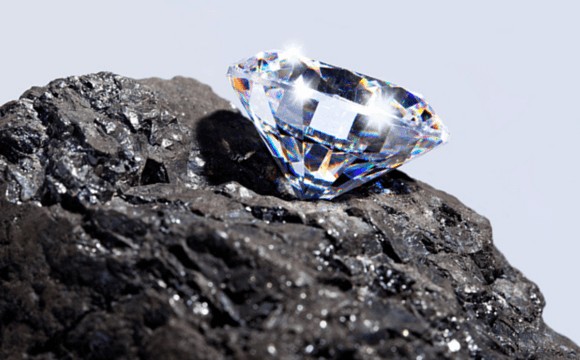
How old do you think the average diamond is? One thousand years? One million, maybe? Try one to three billion years old. Diamond formation is not a fast or simple process. In addition to time, it also takes incredible heat, massive pressure, and carbon to produce diamonds. The rare conditions necessary to produce diamonds are part of what makes them so precious.
The Earth’s Mantle
The earth’s mantle is one of the few places on earth where the temperatures are high enough—and the pressure is great enough—to form diamonds. But only a small portion of the earth’s mantle is suitable for diamond formation. The carbon rocks and high temperatures needed for diamond creation can be found 90 miles deep into the earth’s crust.
But the pressure needed to create diamonds isn’t as predictable as the temperature. Scientists theorize that the pressure needed to create diamonds is present beneath the center of continental plates, where the pressure is steady. Diamonds are created and stored in these “diamond stability zones” until they’re brought to the earth’s surface in a deep-source eruption. This incredibly rare type of eruption rips out a piece of the mantle, and carries it to the surface at an extraordinarily rapid rate.
The diamonds are then dispersed throughout the earth’s crust, where they can be found for billions of years. Scientists estimate that all of the naturally occurring diamonds sold commercially were created this way in the earth’s mantle.
Subduction Zones
Another way diamonds are formed is in what’s called a subduction zone, which occurs when two tectonic plates collide, and one is forced down into the earth’s mantle. When carbon rocks from the surface are subjected to the increasing heat of the mantle combined with the pressure from the colliding plates, tiny diamonds are formed in these rocks.
This process can occur at slightly lower temperatures and shallower depths than those necessary for diamond formation in the “diamond stability zones.” When the subducted rocks return to the crust, these small diamonds can be found within them. Subduction-zone diamonds’ small size and lack of clarity make them unsuitable for industrial or commercial use.
Impact Sites
An asteroid colliding with carbon rocks creates the pressure and heat needed to produce diamonds. The theory that an asteroid impact could create diamonds has been supported by the presence of very small diamonds found at asteroid crash sites. Like subduction-zone diamonds, impact-site diamonds aren’t suitable for use, because they’re small and of low quality.
Space Diamonds
Scientists from both NASA and the Smithsonian have found diamonds in meteorites. With carbon in the meteorites, and the heat and pressure necessary for diamond formation present in the meteorites’ creation, it’s logical that diamonds could be found in meteorites. Unfortunately, much like subduction-zone diamonds and impact-site diamonds, meteorite diamonds aren’t fit for industrial or commercial use.
Liberty Coin & Currency specializes in rare coins and currency. We are a family-owned business located in Portland and Vancouver. We also buy gold, silver, diamonds, and jewelry. Visit us first for a free evaluation.
Like this post? Let us know on Facebook, Twitter, Instagram, Pinterest, or Google+.







